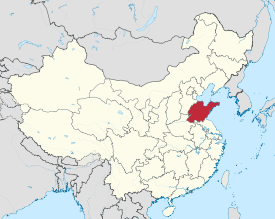
Back Shandong ACE Shandong Afrikaans شاندونغ Arabic Shandong AST Şantun Azerbaijani Шаньдун Byelorussian Шандун Bulgarian শানতুং Bengali/Bangla ཧྲན་ཏུང་ཞིང་ཆེན། Tibetan Shandong Breton
Shandong
山东 | |
|---|---|
| Province of Shandong | |
| Name transcription(s) | |
| • Chinese | 山东省 Shāndōng shěng |
| • Abbreviation | SD / 鲁 Lǔ |
 Location of Shandong within China | |
| Coordinates: 36°24′N 118°24′E / 36.4°N 118.4°E | |
| Country | China |
| Named for |
|
| Capital | Jinan |
| Largest city | Linyi |
| Divisions | 16 prefectures, 140 counties, 1941 townships |
| Government | |
| • Type | Province |
| • Body | Shandong Provincial People's Congress |
| • CCP Secretary | Lin Wu[1] |
| • Congress chairman | Lin Wu |
| • Governor | Zhou Naixiang |
| • CPPCC chairman | Ge Huijun |
| • National People's Congress Representation | 174 deputies |
| Area | |
| • Total | 157,100 km2 (60,700 sq mi) |
| • Rank | 20th |
| Highest elevation | 1,545 m (5,069 ft) |
| Population (2020)[3] | |
| • Total | 101,527,453 |
| • Rank | 2nd |
| • Density | 650/km2 (1,700/sq mi) |
| • Rank | 5th |
| Demonym | Shandongese |
| Demographics | |
| • Ethnic composition | |
| • Languages and dialects | Jiaoliao Mandarin, Jilu Mandarin, Zhongyuan Mandarin |
| GDP[4] | |
| • Total | CN¥9.20 trillion (US$1.3 trillion) |
| • Per capita | CN¥81,846 (US$12,689) |
| ISO 3166 code | CN-SD |
| HDI (2019) | high · 14th |
| Website | www |
| Shandong | |||||||||||||||||||||||||||||||||
|---|---|---|---|---|---|---|---|---|---|---|---|---|---|---|---|---|---|---|---|---|---|---|---|---|---|---|---|---|---|---|---|---|---|
 "Shandong" in simplified (top) and traditional (bottom) Chinese characters | |||||||||||||||||||||||||||||||||
| Simplified Chinese | 山东 | ||||||||||||||||||||||||||||||||
| Traditional Chinese | 山東 | ||||||||||||||||||||||||||||||||
| Literal meaning | East of the Taihang Mountains | ||||||||||||||||||||||||||||||||
| |||||||||||||||||||||||||||||||||
Shandong[a] is a coastal province in East China.[8] Shandong has played a major role in Chinese history since the beginning of Chinese civilization along the lower reaches of the Yellow River. It has served as a pivotal cultural and religious center for Taoism, Chinese Buddhism and Confucianism. Shandong's Mount Tai is the most revered mountain of Taoism and a site with one of the longest histories of continuous religious worship in the world.[9] The Buddhist temples in the mountains south of the provincial capital of Jinan were once among the foremost Buddhist sites in China.[10] The city of Qufu was the birthplace of Confucius, and later became the center of Confucianism.[11]
Shandong's location at the intersection of ancient and modern north–south and east–west trading routes has helped establish it as an economic center. After a period of political instability and economic hardship beginning in the late 19th century, Shandong has experienced rapid growth in recent decades. Home to over 100 million inhabitants, Shandong is the world's sixth-most populous subnational entity, and China's second-most populous province.[12] The economy of Shandong is China's third-largest provincial economy with a GDP of CN¥8.3 trillion (US$1.3 trillion) in 2021, equivalent to the GDP of Mexico.[13][14] If considered among sovereign states, Shandong would rank as the 15th-largest economy and the 15th-most populous as of 2021[update].[15] Its GDP per capita is around the national average.
Shandong is one of China's leading provinces in education and research. It has 153 higher education institutions, ranking second in East China after Jiangsu and fourth among all Chinese first-level divisions after Jiangsu, Guangdong and Henan.[16] As of 2023[update], the Nature Index ranked Jinan ranked 32nd and Qingdao 43rd in the top 50 cities in the world by scientific research output.[17]
- ^ Назначены новые секретари парткомов провинций Шаньдун и Шаньси (in Russian). dknews.kz. 30 December 2022. Archived from the original on 30 December 2022.
- ^ "Doing Business in China". Ministry Of Commerce. n.d. Archived from the original on 16 October 2015. Retrieved 5 August 2013.
- ^ "Communiqué of the Seventh National Population Census (No. 3)". National Bureau of Statistics of China. 11 May 2021. Archived from the original on 11 May 2021. Retrieved 11 May 2021.
- ^ "山东省2021年GDP突破8.3万亿,同比增长8.3%" (in Chinese). SD News. 20 January 2022. Archived from the original on 23 January 2022. Retrieved 9 August 2022.
- ^ "Subnational HDI (v5.0)". Global Data Lab. 2019. Archived from the original on 23 September 2018. Retrieved 1 January 2022.
- ^ "Shandong". Lexico UK English Dictionary. Oxford University Press. Archived from the original on 18 May 2021.
- ^ "Shandong". Merriam-Webster.com Dictionary.
- ^ Tian Xia; Bai Bo (2005). Atlas of World Heritage—China. Long River Press. p. 70. ISBN 9781592650606.
- ^ "Mount Taishan". UNESCO. n.d. Archived from the original on 21 November 2020. Retrieved 30 September 2019.
- ^ Kelly, Margaret, ed. (2007). China. Fodor's Travel Publications. ISBN 978-1-400-01731-7.
- ^ Berling, Judith A. (n.d.). "Confucianism". Asia Society. Archived from the original on 16 November 2020. Retrieved 9 August 2022.
- ^ "Main Data of the Seventh National Population Census". National Bureau of Statistics of China. 11 May 2021. Archived from the original on 11 May 2021.
- ^ "Decoding China's 2021 GDP Growth Rate: A Look at Regional Numbers". China Briefing News. 7 February 2022. Archived from the original on 19 August 2022. Retrieved 15 September 2022.
- ^ "GDP of Mexico". World Bank. Archived from the original on 15 September 2022. Retrieved 15 September 2022.
- ^ "GDP Data". World Bank. Archived from the original on 15 September 2022. Retrieved 15 September 2022.
- ^ ""List of National Colleges and Universities - Government Portal of the Ministry of Education of the People's Republic of China"". Ministry of Education of the People's Republic of China. Archived from the original on 19 June 2022. Retrieved 7 November 2022.
- ^ "Nature Index 2023 Science Cities". Nature. Archived from the original on 22 November 2023. Retrieved 22 November 2023.
Cite error: There are <ref group=lower-alpha> tags or {{efn}} templates on this page, but the references will not show without a {{reflist|group=lower-alpha}} template or {{notelist}} template (see the help page).
© MMXXIII Rich X Search. We shall prevail. All rights reserved. Rich X Search







